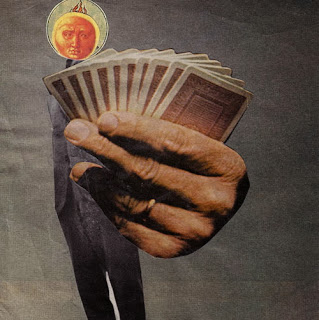"Finnegans Wake is a meta-system that at our level does not exist at all because at our level only its plural constituents exist as such. Finnegans Wake is an organization, a structuring, of these constituents, in which they are unified into one entity. Meanwhile the plural constituents at our level behave—or seem to behave—as if unrelated to one another. An entirely new and higher way of organizing the ontological categories by which perception is structured must be reached by the observer.
Thus in a sense Finnegans Wake does not exist, but is brought into existence parallel with the percipient’s awareness of it, this having to do with the participant-observer of quantum mechanics. The percipient must participate in being Finnegans Wake to be aware of Finnegans Wake. However, Finnegans Wake is real and is subsuming progressively more and more of its environment. Its internal complexity continually grows. Its metabolism seems to be information and the processing of information. Its plural constituents are arranged in such a way as to constitute a language or information or messages; if you cannot see the arrangement you cannot read the message. And you cannot perceive Finnegans Wake.
So in a sense perceiving Finnegans Wake is reading the message that Finnegans Wake has
arranged constituents into. Not necessarily understanding the message but recognizing it as a message.
Finnegans Wake is both there and not there. When it is not perceived it is not there (as opposed to: when it is not there it is not perceived). It is a way of perceiving reality—which demands a percipient—but when perceived it has definite and intricate characteristics; it is not vague. It consists of structure but a percipient is necessary for that structure to come into being. But the structure is not in the percipient’s mind imposed or projected onto reality. Finnegans Wake did not exist until it was perceived; therefore to experience it is to effect a repair in the Ground of Being (Finnegans Wake being considered as the Ground of Being).
One highly important element about Finnegans Wake is that it is eternal, although it changes; it can be added to, become more complex, arborizing and reticulated, but once a constituent is incorporated into it that constituent can never cease to be. Thus Finnegans Wake lies outside the flux of the world we see. However, Finnegans Wake’ world is this world differently perceived, not another world; but it is a quantum leap upward in hierarchy, in which plural constituents become a unity by reason of integrating structure. That structure is added—supplied—by the percipient.
Finnegans Wake and the perception of Finnegans Wake occur simultaneously, and neither can be separated from the other, ever, at any time.
Finnegans Wake is everywhere—that is, it can be perceived everywhere. It is not in a meta-reality but is a meta-system made entirely from this reality.
By perceiving Finnegans Wake one participates in the sudden total transformation from plural unrelated constituents to a unitary structure. It is as if Finnegans Wake feeds off the percipient’s perception of structure using perception of structure as structure. But this is an acausal relationship, a kind of parallelism; it is ex nihilo. Finnegans Wake came out of nothing. Reality did not evolve into Finnegans Wake. It became Finnegans Wake when perceived as Finnegans Wake. There are no antithetical forces in Finnegans Wake; the dialectic does not exist when Finnegans Wake does. But when Finnegans Wake ceases to exist, there again is the dialectic. Finnegans Wake uses the dialectic to come into greater being, to grow, assimilate its environment, incorporate new pieces, make itself more inclusive and complex: more Finnegans Wakeish. Finnegans Wake could be compared to the point at which a liquid becomes saturated or when water freezes, except that perception of this is necessary for it to occur.
There you have an analogy.
Even more strange, Finnegans Wake induces a potential percipient to perceive it and thus cause it (Finnegans Wake) to occur . . . thus it can be said that during its nonexistence Finnegans Wake is able to cause its own existence. At the time that it laid down steps to bring itself into existence it did not yet exist. Thus it treats time differently than we do; it is not passive in relation to time. When it thus brings itself into existence it is already an extensive system. Hence one can say, Finnegans Wake comes and goes but is always in a sense present. The percipient sees Finnegans Wake because Finnegans Wake causes the percipient to see it, but Finnegans Wake did not come into existence until the percipient saw it. Thus the effects of Finnegans Wake are felt before Finnegans Wake exists, and these effects are to be regarded as acausal; they have no cause because their cause does not yet exist. It will exist later; then, retroactively, these effects will have had a cause. What is represented here is total homeostasis: an entity that is entirely self-generating, on which nothing acts but its own internal volition. Therefore in a sense it can be said that Finnegans Wake is (or becomes) anything that acts to cause it to come into existence, which is to say, by perceiving it. This involves laws of physics about which we know nothing, I would think. What certainly is involved, indubitably, is not a more complex entity than we normally know of or have ever heard of, but an entity operating under laws different from the laws we are aware of, including ontological categories of perception organized in ways we have never heard of. Greater complexity is not the key to Finnegans Wake; utilizing of more complex physics is the key to Finnegans Wake.
In a certain real sense Finnegans Wake is very simple; it is a unit. You could think of it as a protozoon, a single cell at a higher level of reality, where the laws of space, time and causation are different; and it makes use of that difference. We humans are very complex forms that matter takes at this ontological level of reality, or, if you will, at this level of physics; Finnegans Wake is a very simple organization at the next level up.
The billions of constituents of our level form a single cell at its level; these constituents are subsumed and yet at the same time at this level of reality they go about their business as usual. So in a sense Finnegans Wake has no effect on this world. But in another sense it has complete control of this world. Both statements are equally true, depending on whether you can see Finnegans Wake or not.
This especially applies to the patterns that Finnegans Wake is or creates in our world in which broad sequences of events add up to a coherency. It can be said: There is coherence; there is not coherence. Coherence and Finnegans Wake are the same. Since Finnegans Wake in a very literal way is our world, its internal structure is a latent (concealed) coherence of our world. (All the constituents of Finnegans Wake are elements of our world; it—Finnegans Wake—has nothing else to draw on and it needs nothing else to draw on.) Thus it is possible when viewing Finnegans Wake to view Finnegans Wake as our world and our world as Finnegans Wake.
One can say of Finnegans Wake, then, that Finnegans Wake is a way our world can be seen to be. Its structure is the structure of our world. Developments in Finnegans Wake are developments in our world. Volition in Finnegans Wake is volition in and of our world. There is no difference between Finnegans Wake and our world except that Finnegans Wake is a certain way of seeing our world in terms of it being a kind of single unit all parts of which are interconnected purposefully and everything is coherent. (In other words it is precisely what Pythagoras called kosmos: the orderly fitting-together of the beautiful.)
Viewed this way it operates from internal necessity without the need of any sort of adventitious deity. It is not world to God—creation to Creator—but having its own logic and making its own choices. It chooses continually after examining all the possible choices arranged as information into a sort of narrative made out of language. Nothing created it; it brought itself into being ex nihilo by willing the perception of it—of necessity from within itself, which is a self-awareness. Thus the percipient of Finnegans Wake and Finnegans Wake are part of one field."
Philip K Dick On Valis, June 1980

























































